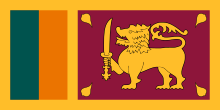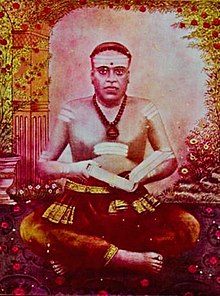Portal:Sri Lanka
The Sri Lanka Portal Sri Lanka, historically known as Ceylon and officially the Democratic Socialist Republic of Sri Lanka, is an island country in South Asia. It lies in the Indian Ocean, southwest of the Bay of Bengal, separated from the Indian peninsula by the Gulf of Mannar and the Palk Strait. It shares a maritime border with the Maldives in the southwest and India in the northwest. Sri Lanka has a population of approximately 22 million and is home to many cultures, languages and ethnicities. The Sinhalese people form the majority of the population, followed by the Sri Lankan Tamils, who are the largest minority group and are concentrated in northern Sri Lanka; both groups have played an influential role in the island's history. Other long-established groups include the Moors, Indian Tamils, Burghers, Malays, Chinese, and Vedda. Sri Lanka's documented history goes back 3,000 years, with evidence of prehistoric human settlements dating back 125,000 years. The earliest known Buddhist writings of Sri Lanka, known collectively as the Pāli canon, date to the fourth Buddhist council, which took place in 29 BCE. Also called the Pearl of the Indian Ocean, or the Granary of the East, Sri Lanka's geographic location and deep harbours have made it of great strategic importance, from the earliest days of the ancient Silk Road trade route to today's so-called maritime Silk Road. Because its location made it a major trading hub, it was already known to both East Asians and Europeans as long ago as the Anuradhapura period. During a period of great political crisis in the Kingdom of Kotte, the Portuguese arrived in Sri Lanka and sought to control its maritime trade, with a part of Sri Lanka subsequently becoming a Portuguese possession. After the Sinhalese-Portuguese war, the Dutch Empire and the Kingdom of Kandy took control of those areas. The Dutch possessions were then taken by the British, who later extended their control over the whole island, colonising it from 1815 to 1948. A national movement for political independence arose in the early 20th century, and in 1948, Ceylon became a dominion. It was succeeded by the republic of Sri Lanka in 1972. Sri Lanka's more recent history was marred by a 26-year civil war, which began in 1983 and ended in 2009, when the Sri Lanka Armed Forces defeated the Liberation Tigers of Tamil Eelam. (Full article...) Selected article -The Invasion of Ceylon was a military campaign fought as a series of amphibious operations between the summer of 1795 and spring of 1796 between the garrison of the Batavian colonies on the Indian Ocean island of Ceylon (now Sri Lanka) and a British invasion force sent from British India. The Dutch Republic had been a British ally during the French Revolutionary Wars, but was overrun by the French Republic in the winter of 1794 and reformed into the client state of the Batavian Republic. The British government, working with the exiled Stadtholder William of Orange, ordered the seizure of Batavian assets including colonies of the former Dutch Empire. Among the first territories to be attacked were those on the coast of the island of Ceylon, with operations initially focused on the trading port at Trincomalee. To achieve the seizure of the colony, the British government instructed Lord Hobart, Governor of Madras to use the forces at his disposal to invade and capture the Batavian-held parts of the island. Prosecution of the campaign was given to Colonel James Stuart, supported by naval forces under Rear-Admiral Peter Rainier. Stuart called on Batavian governor Johan van Angelbeek to surrender the colony peacefully and many trading posts were taken without resistance, but Stuart's forces were opposed at Trincomalee in August 1795 and briefly at Colombo in February 1796. Following short sieges British forces were able to secure control of the Dutch colony, and Ceylon would remain a part of the British Empire for the next 153 years. (Full article...)General imagesThe following are images from various Sri Lanka-related articles on Wikipedia.
Related portalsIndian Subcontinent Other countries Selected biography - Arumuka Navalar (Tamil: ஆறுமுக நாவலர், romanized: Āṟumuka Nāvalar, lit. 'Arumuka the Orator'; 18 December 1822 – 5 December 1879) was a Sri Lankan Shaivite Tamil language scholar and a religious reformer who was central in reviving native Hindu Tamil traditions in Sri Lanka and India. Navalar's birth name was Nallur Arumuka Pillai. He was born in a Tamil literary family, and became one of the Jaffna Tamils notable for reviving, reforming and reasserting the Hindu Shaivism tradition during the colonial era. As an assistant working for Peter Percival – a Methodist Christian missionary, he helped translate the King James Bible into the Tamil language.he established Hindu schools and published a press in order to publish reading materials for Hindu children to educate them on Hindu religion and also practice and rituals of Hindu religion. With his knowledge of Christian theological premises, Navalar became influential in creating a period of intense religious rivalry with Christian missionaries, defending Tamils and their historic religious culture in India and Sri Lanka, preventing large-scale conversions to Christianity. (Full article...)Did you know (auto-generated)
Selected pictureMore did you know -
TopicsSubcategoriesNew articlesThis list was generated from these rules. Questions and feedback are always welcome! The search is being run daily with the most recent ~14 days of results. Note: Some articles may not be relevant to this project.
Rules | Match log | Results page (for watching) | Last updated: 2024-05-25 22:03 (UTC) Note: The list display can now be customized by each user. See List display personalization for details.
Web resourcesThings you can doWikipedias in Sri Lankan languagesAssociated WikimediaThe following Wikimedia Foundation sister projects provide more on this subject:
Discover Wikipedia using portals |





































































